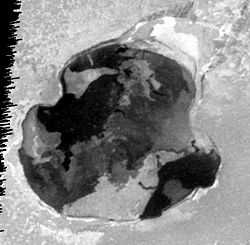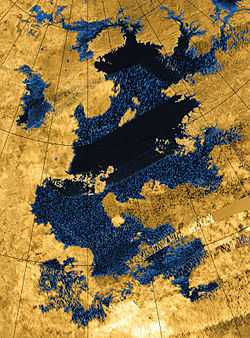List of largest lakes and seas in the Solar System
Following are the largest lakes and seas on various worlds of the Solar System. Listed are single bodies of water or other liquid on or near the surface of a solid body (terrestrial planet, planetoid, or moon).
Cold surface oceans or lakes are found on two worlds, Earth and Saturn's moon Titan. Lava lakes are found on Earth and Jupiter's moon Io. Subsurface oceans or seas occur on the other Galilean moons of Jupiter, Saturn's moons Titan and Enceladus, and are suspected on the some of Saturn's other moons, the asteroid Ceres, the larger trans-Neptunian objects, and ice planets in planetary systems. Recent analysis of the interior of Ganymede, taking into account the effects of salt, suggests that it and some of the other icy bodies may not have a single interior global ocean but several stacked above and below each other, separated by different phases of ice, with the lowest liquid layer adjacent to the rocky mantle below.[1][2]
| Body | Lake/sea | Area (km2) | Average depth (km) | Notes | |
|---|---|---|---|---|---|
| Earth | Ocean Sea | 361,300,000 | 3.68 (max 11.02) |  |
71% of Earth's surface |
| Caspian Sea | 371,000 | 0.21 (max 1.02) |  |
smallest ocean (geological) (0.07% of Earth's surface) | |
| Lake Huron–Michigan | 117,400 | 0.07 (max 0.28) | .png) |
largest lake today (geological) | |
| West Siberian Glacial Lake | c. 880,000 (50–60 ka) |
0.036 | glacial lakes during the Ice Age | ||
| Lake Agassiz | c. 440,000 (max) | ? | |||
| Ceres (asteroid) |
(internal ocean) | c. 1,000,000? | possible subsurface equatorial ocean | ||
| Io (Jovian moon) |
Gish Bar Patera | 9,600 | ? |  |
lava lakes |
| Loki Patera | < 32,000 | ? | .jpg) | ||
| Europa (Jovian moon) |
(internal global ocean) | c. 30,000,000 | est. 50–100 | global ocean under 10 to 30 km of ice, perhaps twice the volume of Earth's ocean | |
| Ganymede (Jovian moon) |
(internal global ocean) | c. 80,000,000 apiece | 100 | 100 km thick, under 150 km of ice, six times the volume of Earth's ocean. possibly three oceans, one under another | |
| Callisto (Jovian moon) |
(internal global ocean) | c. 65,000,000 | 120–180 | global ocean under 135 to 150 km of ice | |
| Titan (Saturnian moon) |
Kraken Mare | ≈ 400,000 (0.5% of Titan's surface) |
? |  |
hydrocarbon lakes |
| Ligeia Mare | 126,000 | (0.17 in places) | .jpg) | ||
| (internal global ocean) | c. 80,000,000 | < 300 | global ocean of water under < 100 km of ice | ||
| Enceladus (Saturnian moon) |
South Pole reservoir | ? | up to 8 | local or regional ocean at south pole, under 30 to 40 km of ice; volume c. 10,000 km3[3] | |
| Dione (Saturnian moon) |
(internal global ocean) | c. 1,000,000 | ? | possible global ocean under the ice | |
| Rhea (Saturnian moon) |
(internal global ocean) | c. 1–2,000,000 | c. 15 | possible global ocean under the ice (c. 400 km) | |
| Titania (Uranian moon) |
(internal global ocean) | c. 5,000,000 | c. 15–50 | possible global ocean under the ice (c. 150–200 km) | |
| Oberon (Uranian moon) |
(internal global ocean) | c. 3,000,000 | c. 15–40 | possible global ocean under the ice (c. 250 km) | |
| Triton (Neptunian moon) |
(internal global ocean) | c. 20,000,000 | c. 150–200 | possible global ocean under the ice (c. 150–200 km) | |
| Orcus (KBO) | (internal global ocean) | c. 500,000 | c. 15 | possible global ocean under the ice (c. 200 km) | |
| Pluto (KBO) | (internal global ocean) | c. 10–15,000,000 | c. 100–180 | possible global ocean under the ice (c. 150–230 km) | |
| Makemake (KBO) | (internal global ocean) | c. 3,000,000 | ? | possible global ocean under the ice | |
| 2007 OR10 (SDO) | (internal global ocean) | c. 2–3,000,000 | ? | possible global ocean under the ice | |
| Eris (SDO) | (internal global ocean) | c. 10,000,000 | c. 150–200 | possible global ocean under the ice (c. 150–250 km) | |
| Sedna (sednoid) | (internal global ocean) | c. 1,000,000 | c. 15 | possible global ocean under the ice (c. 200 km) |
See also
- List of tallest mountains in the Solar System
- List of largest rifts and valleys in the Solar System
- List of largest craters in the Solar System
References
- ↑ Clavin, W. (2014-05-01). "Ganymede May Harbor 'Club Sandwich' of Oceans and Ice". Press release. Jet Propulsion Laboratory. Archived from the original on 2014-05-02. Retrieved 2014-05-04.
- ↑ Vance, S.; Bouffard, M.; Choukroun, M.; Sotin, C. (2014-04-12). "Ganymede׳s internal structure including thermodynamics of magnesium sulfate oceans in contact with ice". Planetary and Space Science. doi:10.1016/j.pss.2014.03.011.
- ↑ Grossman, L. (2014-04-03). "Buried 'Lake Superior' seen on Saturn's moon Enceladus". New Scientist web site. New Scientist. Archived from the original on 2014-04-20. Retrieved 2014-04-21.